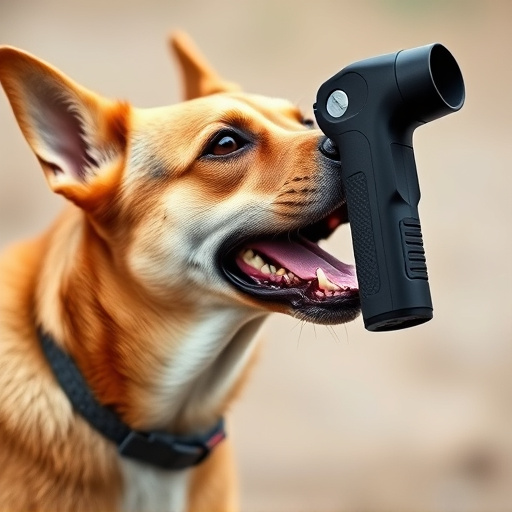Animal control pepper spray is a non-lethal tool for de-escalating aggressive animal encounters, offering a temporary incapacitation without permanent harm. Effective within 3-4 meters, it allows time for escape or emergency care. Training, awareness of range and effects, and immediate water washing post-exposure are crucial. In cases of exposure, swift action—including rinsing eyes/nose/mouth, monitoring for distress, providing respiratory support, warmth, and contacting a veterinarian—is vital for animal welfare. Responsible usage requires understanding local laws, proper training, and adhering to guidelines, prioritizing humane and ethical treatment while mitigating harm and considering legal implications.
Animal control pepper spray has emerged as a powerful yet non-lethal tool in managing aggressive animals. This article delves into the effectiveness, range, and application guidelines of animal control pepper spray, highlighting its role in public safety. We explore how this substance works against various wildlife and domestic animals, focusing on emergency care for those exposed. Additionally, we discuss legal considerations and responsible use practices to ensure the safe and effective deployment of animal control pepper spray.
- Understanding Animal Control Pepper Spray: A Non-Lethal Approach
- The Range and Effectiveness of Pepper Spray for Animals
- Emergency Care Guidelines After Exposure to Pepper Spray
- Legal Considerations and Responsible Use of Animal Control Pepper Spray
Understanding Animal Control Pepper Spray: A Non-Lethal Approach
Animal control pepper spray is a non-lethal tool designed to temporarily incapacitate and deter aggressive animals, providing vital time for emergency care or escape. Unlike traditional weapons, it does not cause permanent harm or death, making it a preferred option in situations where capturing or tranquilizing an animal may be difficult or dangerous. This type of spray is particularly useful for dealing with wild animals or domestic pets that have become uncontrollable due to fear, pain, or distress.
When deployed correctly, pepper spray can disrupt an animal’s sensory perception and motor functions, allowing individuals to administer emergency care or safely remove the animal from a hazardous environment. It’s crucial to note that proper training and understanding of the spray’s range and effects are essential for its effective and responsible use. In many cases, immediate medical attention is required after exposure to pepper spray, especially in vulnerable populations such as children, the elderly, and individuals with pre-existing respiratory conditions.
The Range and Effectiveness of Pepper Spray for Animals
Pepper spray, when used correctly, can be an effective tool in managing and controlling animals, offering a non-lethal method of self-defense against aggressive or dangerous wildlife encounters. The range at which pepper spray is effective can vary greatly depending on factors like the user’s strength, wind conditions, and the animal’s size and behavior. Typically, pepper spray has a reach of about 3 to 4 meters (10-13 feet), allowing users to maintain distance from potentially hazardous animals.
The active ingredient in pepper spray, capsaicin, irritates the animal’s eyes, nose, and throat, temporarily disabling them. This provides crucial time for individuals to seek emergency care or escape the area safely. However, it’s essential to note that pepper spray is not a cure-all, and its effectiveness can be influenced by weather conditions, the animal’s tolerance to capsaicin, and their overall aggression. In cases of emergency care for maced animals, immediate washing of affected areas with water is recommended to minimize discomfort and irritation.
Emergency Care Guidelines After Exposure to Pepper Spray
In the event of emergency care for animals exposed to pepper spray, it’s crucial to act swiftly and decisively. The first step is to immediately remove any animal from the affected area to prevent further exposure. Wash the eyes, nose, and mouth of the distressed animal with copious amounts of clean water, ensuring all traces of the spray are removed. This quick action can significantly alleviate discomfort and prevent potential long-term damage.
Afterward, monitor the animal for any signs of distress or adverse reactions. If breathing is compromised, administer artificial respiration if trained to do so. Keep the affected animal warm and calm, as stress can exacerbate the effects of pepper spray. It’s essential to contact a veterinarian immediately, explaining the situation clearly. They can provide specific advice tailored to the animal’s condition and recommend further emergency care procedures.
Legal Considerations and Responsible Use of Animal Control Pepper Spray
The use of animal control pepper spray, also known as oleoresin capsicum (OC) spray, is a controversial topic and its application is strictly regulated by law in many jurisdictions to ensure public safety and responsible usage. Before considering this method for animal control, it’s crucial to understand the legal implications and guidelines surrounding its use. Pepper spray designed for animal control purposes typically contains a lower concentration of OC than that used by law enforcement, but it still poses significant risks if mishandled or used inappropriately.
Responsible use involves adhering to local regulations, obtaining proper training, and prioritizing non-lethal methods whenever possible. In many cases, emergency care for maced animals becomes a critical concern after pepper spray is deployed. It’s essential for individuals carrying such devices to be well-versed in decontamination procedures and post-exposure care to minimize harm to both the animal and themselves. This includes understanding the legal repercussions of using force and ensuring that all actions taken are in line with local animal welfare laws, promoting humane and ethical treatment of animals at all times.
Animal control pepper spray, a non-lethal solution, offers a safe and effective way to manage aggressive animal encounters. Understanding its range, effectiveness, and proper usage is crucial for both professionals and individuals seeking emergency care for maced animals. By adhering to legal guidelines and implementing responsible practices, this tool can help navigate challenging situations while ensuring the well-being of both humans and animals involved. Remember, prompt emergency care is vital after exposure to pepper spray to minimize discomfort and promote swift recovery.
